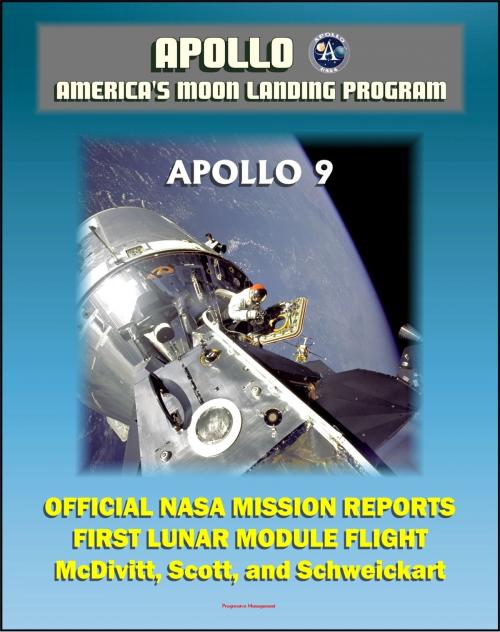Apollo and America's Moon Landing Program: Apollo 9 Official NASA Mission Reports and Press Kit - 1969 First Manned Flight of the Lunar Module in Earth Orbit by McDivitt, Scott, and Schweickart
Nonfiction, Science & Nature, Science, Physics, Astronomy, History, Americas| Author: | Progressive Management | ISBN: | 9781465703835 |
| Publisher: | Progressive Management | Publication: | November 15, 2011 |
| Imprint: | Smashwords Edition | Language: | English |
| Author: | Progressive Management |
| ISBN: | 9781465703835 |
| Publisher: | Progressive Management |
| Publication: | November 15, 2011 |
| Imprint: | Smashwords Edition |
| Language: | English |
Three comprehensive official NASA documents - converted for accurate flowing-text e-book format reproduction - chronicle the vital first manned test flight of the Apollo lunar module, Apollo 9, conducted by astronauts McDivitt, Scott, and Schweickart in early 1969.
Two technical mission reports, the Manned Spacecraft Center (MSC) Apollo 8 Mission Report and the NASA Headquarters Mission Operation Report (MOR), provide complete details about every aspect of the mission.
Apollo 9 MSC Mission Report: Mission description, pilots' report, communications, trajectory, command and service module performance, mission support performance, assessment of mission objectives, launch vehicle summary, anomaly summary (CSM, LM, government furnished equipment), conclusions, vehicle descriptions. Apollo 9 MOR: Mission design and execution, spacecraft performance, flight anomalies, detailed objectives and experiments, launch countdown, detailed flight mission description, back contamination program, contingency operations, configuration differences, mission support, recovery support plan, flight crew, mission management responsibility, program management, abbreviations and acronyms. Apollo 9 Press Kit: Detailed preview from countdown to landing.
Apollo 9 was the first manned flight of the lunar module and was conducted to qualify this portion of the spacecraft for lunar operations. The crew members were James A. McDivitt, Commander; David R. Scott, Command Module Pilot; and Russell L. Schweikart, Lunar Module Pilot.
The primary objectives of the mission were to evaluate crew operation of the lunar module and to demonstrate docked vehicle functions in an earth orbital mission, thereby qualifying the combined spacecraft for lunar flight. Lunar module operations included a descent engine firing while docked with the command module, a complete rendezvous and docking profile, and, with the vehicle unmanned, an ascent engine firing to propellant depletion. Combined spacecraft functions included command module docking with the lunar module (after transposition), spacecraft ejection from the launch vehicle, five service propulsion firings while docked, a docked descent engine firing, and extravehicular crew operations from both the lunar and command modules. These primary objectives were all satisfied.
All spacecraft systems operated satisfactorily in performing the mission as planned. The thermal response of both spacecraft remained within expected ranges for an earth orbital flight, and consumable usages were maintained within acceptable limits. Management of the many complex systems of both spacecraft by the crew was very effective, and communications quality was generally satisfactory.
Three comprehensive official NASA documents - converted for accurate flowing-text e-book format reproduction - chronicle the vital first manned test flight of the Apollo lunar module, Apollo 9, conducted by astronauts McDivitt, Scott, and Schweickart in early 1969.
Two technical mission reports, the Manned Spacecraft Center (MSC) Apollo 8 Mission Report and the NASA Headquarters Mission Operation Report (MOR), provide complete details about every aspect of the mission.
Apollo 9 MSC Mission Report: Mission description, pilots' report, communications, trajectory, command and service module performance, mission support performance, assessment of mission objectives, launch vehicle summary, anomaly summary (CSM, LM, government furnished equipment), conclusions, vehicle descriptions. Apollo 9 MOR: Mission design and execution, spacecraft performance, flight anomalies, detailed objectives and experiments, launch countdown, detailed flight mission description, back contamination program, contingency operations, configuration differences, mission support, recovery support plan, flight crew, mission management responsibility, program management, abbreviations and acronyms. Apollo 9 Press Kit: Detailed preview from countdown to landing.
Apollo 9 was the first manned flight of the lunar module and was conducted to qualify this portion of the spacecraft for lunar operations. The crew members were James A. McDivitt, Commander; David R. Scott, Command Module Pilot; and Russell L. Schweikart, Lunar Module Pilot.
The primary objectives of the mission were to evaluate crew operation of the lunar module and to demonstrate docked vehicle functions in an earth orbital mission, thereby qualifying the combined spacecraft for lunar flight. Lunar module operations included a descent engine firing while docked with the command module, a complete rendezvous and docking profile, and, with the vehicle unmanned, an ascent engine firing to propellant depletion. Combined spacecraft functions included command module docking with the lunar module (after transposition), spacecraft ejection from the launch vehicle, five service propulsion firings while docked, a docked descent engine firing, and extravehicular crew operations from both the lunar and command modules. These primary objectives were all satisfied.
All spacecraft systems operated satisfactorily in performing the mission as planned. The thermal response of both spacecraft remained within expected ranges for an earth orbital flight, and consumable usages were maintained within acceptable limits. Management of the many complex systems of both spacecraft by the crew was very effective, and communications quality was generally satisfactory.















